We love to watch social media train wrecks – especially when it’s done by an enormous brand with a seemingly endless supply of cash and staff to execute a successful campaign. Whenever we see one of these blunders, our first response is usually, “Shouldn’t they have known better?”
Much has been written about specific failed social media campaigns, but I couldn’t find an example that categorizes these horrible techniques. What follows are repeated trends social campaign trends. If anyone at your company suggests any of these techniques, make sure you shoot their idiotic idea down as quickly as possible before your company becomes a permanent search term on “what not to do in social media.”
Making jokes about a trending hashtag without knowing what it is
If everyone is paying attention to trending topics, and you want your company to be seen, why not jump on the bandwagon and pointlessly shoehorn your brand into a completely unrelated discussion?
Hashtag hijacking is popular because it’s so easy, even if it’s completely inappropriate. Just drop a silly promotional tweet into all of the trending topics and your brand will be seen by a significant portion of the Twitterverse. That would be all fine if these hashtags weren’t actually connected to real conversations.
FAILED EXAMPLE: @Entenmann’s tweets out “Who’s #notguilty about eating all the tasty treats they want?!” The hashtag was actually referring to the Casey Anthony “Not Guilty” verdict.

Did I hear someone say, “Not guilty?” Well, I’m not guilty of enjoying these delicious crescent rolls… Come on, lighten up, it’s not like I killed her. Who wants a bran muffin?
When a brand is guilty of Twitter buffoonery, the Twitterverse is quick to point out what the brand didn’t bother to look up themselves. Inevitably the brand issues a retraction in the form of an apology tweet saying that they didn’t intend to take the situation so lightly, yet that’s exactly what they did.
Making light of tragedies to make an insensitive promotion joke
What’s worse than the above mistake is when a brand is well aware of a tragedy yet still chooses to use the opportunity to send out a promotional tweet.
FAILED EXAMPLE: Referencing the Hurricane Sandy hashtag, the GAP sends out the following tweet from Foursquare: “All impacted by #Sandy, stay safe! We’ll be doing lots of Gap.com shopping today.”
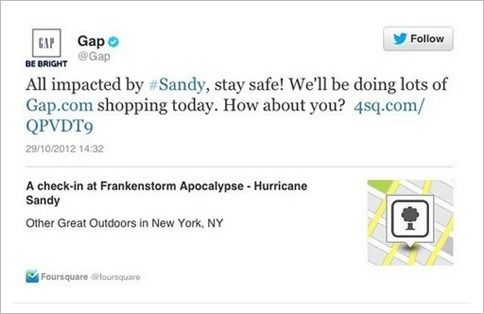
That was followed up with “To all impacted by #Sandy, stay safe. Our check-in and tweet earlier were only meant to remind all to keep safe and indoors.”
Is “doing lots of Gap.com shopping today” a euphemism for piling up sandbags?
Start a donation campaign that requires people to tweet your hashtag #OurCompanyCares
Before Twitter and Facebook, the way companies showed they actually cared about a cause is they’d hold a fundraiser and donate money. It was through their actions that others could actually see that a company cared about a cause.
Raising and donating money takes effort and… money. Another way to show your company cares is by blackmailing the public to promote your hashtag #OurCompanyCares in order for you to release donation funds.
FAILED EXAMPLE: Papa John’s posts on Facebook that they’re concerned about child hunger. They’ve determined that the best way to show you’re concerned about hunger is to “Like” their Facebook post with the hashtag #PapaJohnCares. For every “Like,” comment, or share they’ll donate $1 up to $50,000.
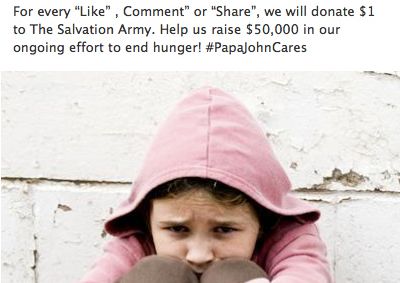
I guess if we don’t “Like” your post enough the kids starve and it’s our fault.
Click “Like” if you’re concerned about the same thing we’re concerned about
Social media has offered a new means for us to grieve. We post about tragedies and look for others equally concerned. Facebook gives us an opportunity to leave a comment, but for those who are concerned yet really lazy, there’s always the option to “Like” a tragedy. Is that really the sentiment you want to send or even encourage?
FAILED EXAMPLE: NBC LA posts a short news story on Facebook about a murdered couple and suggests readers click “Like” to send condolences.
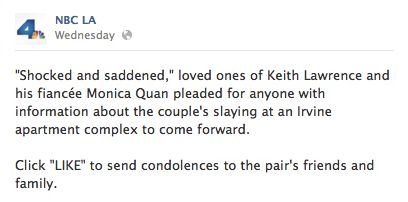
It’s truly the “least” you can do, and your “Likes” will really help boost our Klout score.
Auto replies to customer tweets
“Twitter is all about the conversation” is a mantra that social media experts have been harping on for years. While everyone understands how you’re supposed to use Twitter, some big brands have ignored the obvious advice and decided to institute an auto-reply tweet program that sends generic responses to queries sent to the company’s Twitter account. The advantage of this technique is it simultaneously reduces the cost of hiring customer service professionals while simultaneously speeding up the damage to your corporate brand.
FAILED EXAMPLE: Completely ignoring the content of a tweet, Bank of America responds to every @reply with “We’d be happy to review your account with you to discuss any concerns. Please let us know if you need assistance” or “What happened? Anything I can do to help?”
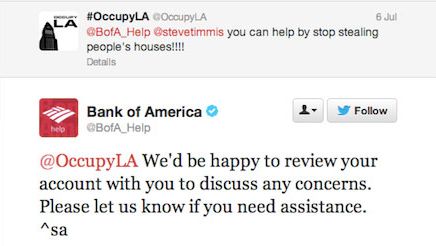
Our generic response shows we ignored your first query. Would you like to try again?
Asking influencers to tweet about your brand
Here’s a bad idea. Publicly introduce yourself to a well-known and highly paid influencer and ask them to send out promotional tweets through their account. Make it clear that you’ll pay them. If that doesn’t work, why not ask them if they’d like to have sex for money.
FAILED EXAMPLE: Unaware that Patton Oswalt is a top touring comedian, and highly paid TV and film actor, Brander Influencers offers the comedian money to send out tweets from his account to promote their clients. Oswalt rejects their offer, and then decides to send out for free a series of hilarious brand-damaging tweets.
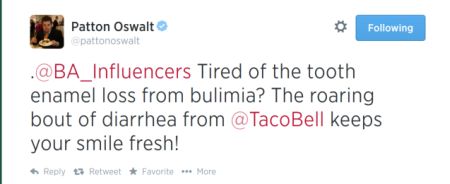
As of February this year, Brander Influencers was still making these “tweets for money” requests. I guess they like the abuse.
Tell your story about how wonderful we are
Ever work at a company where you fool yourself into believing that everyone thinks you’re as fantastic as you think you are? Somehow you’ve convinced yourself and the rest of the company that the only reason the Internet isn’t flush with stories of your spectacular company is because you haven’t publicized a #OurCompanyStories hashtag. That’s it. All you need is a hashtag and people will finally have an opportunity to tell you and the rest of the world how wonderful you really are.
FAILED EXAMPLE: McDonald’s tried to get the “why do you love us” ball rolling by promoting its #McDStories hashtag only to discover people chose to use the hashtag to share horror stories of eating McDonald’s food.
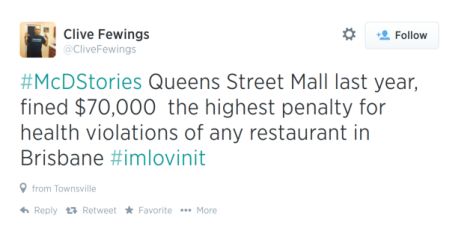
I’m sure there are plenty of positive #McDStories, but a rat in a Big Mac makes a far more enticing and retweetable headline.
CONCLUSION: It’s not all about you
Yes, people like to use social media to promote themselves, but when you do it to take advantage of tragedies or with the hope that people will willingly shill for your brand when your brand is also a target for ridicule, you’re asking for trouble. Instead of forcing behavior, let your audience take control and be pleasantly surprised by the response, no matter what direction the conversation goes.




